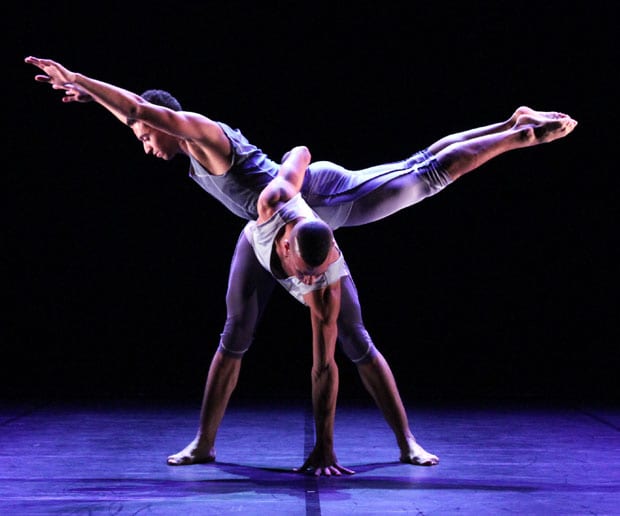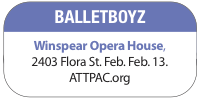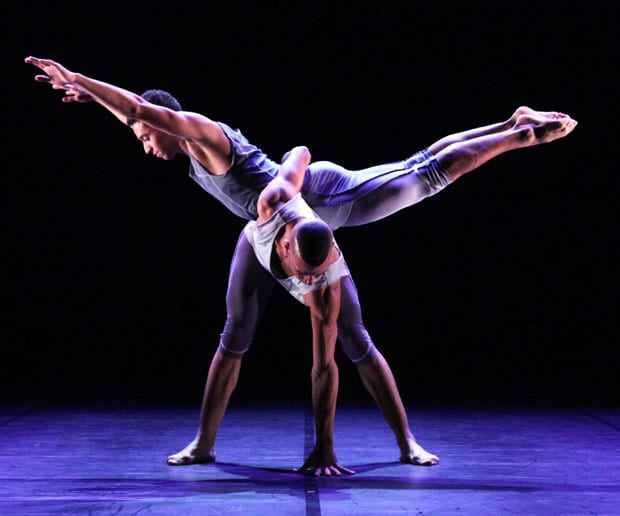BalletBoyz may be an all-male troupe, but don’t expect a campy take on dance during its Dallas debut

MESMERIZING | Choreographer Chris Wheeldon created ‘Mesmerics’ for BalletBoyz, one of two pieces that will mark the all-male company’s Dallas debut this weekend.
ARNOLD WAYNE JONES | Executive Editor
jones@dallasvoice.com
When William Trevitt co-founded his U.K.-based dance modern troupe BalletBoyz around 2000, he and co-founder Michael Nunn were not setting out to turn the world of dance on its head. The goal was far more practical.
“Michael and I first started the company knowing that we could rely on ourselves to turn up for the show and be available for rehearsal,” Trevitt says. Of necessity, they ended up “doing a lot of male duets.” That’s when people started to take notice.
“We had the idea there was more to [this concept] than just the two of us, so we set it up as an all-male dance company, which is relatively unusual. We invited choreographers to work with an all-male cast, and they were fascinated by the possibilities. Choreographers continued to want to have a play with us.”
 Fifteen years later, the idea of a men-only dance company continues to surprise and challenge audiences and artists alike. Trevitt and Nunn are still the artistic directors of BalletBoyz, but neither dances anymore; they have turned those duties over “to this group of 10 enthusiastic, energetic young dancers,” he says. And they continue a legacy that had its roots at the Royal Ballet.
Fifteen years later, the idea of a men-only dance company continues to surprise and challenge audiences and artists alike. Trevitt and Nunn are still the artistic directors of BalletBoyz, but neither dances anymore; they have turned those duties over “to this group of 10 enthusiastic, energetic young dancers,” he says. And they continue a legacy that had its roots at the Royal Ballet.That’s where Trevitt and Nunn were both soloists. A documentary filmmaking company decided to “make a dancer’s-eye-view of ballet. We had a working title for it of Michael and Billy’s Royal Ballet, but the Royal Ballet wasn’t a fan of that,” Trevitt laughs. “The production company said, ‘Well, we’re calling it BalletBoyz with a Z.’ We thought it was awful, but we couldn’t come up with anything else in time, and the marketing people thought it was catchy.”
The name of the company sends mixed signals, for sure; it is not, Trevitt insists, true “ballet;” but neither should the “boyz” spelling suggest anything campy or even hip-hop. Rather, it’s a hybrid of styles — exactly as they set out to make.
“It’s not ballet, but there are a lot of elements you would associate with ballet — it’s lyrical, beautiful. I like to think of it as a progression of ballet,” Trevitt says.
The challenges in establishing an all-male troupe ended up being multifarious. For one, the skills involved on the dancers’ parts were different.
“Obviously, they have to be very physically very strong — they are lifting men their own sizes above their heads,” Trevitt says. And the dynamics of the company are different as well. “What you end up in the studio is a very tight group like firefighters or soldiers — that same camaraderie… though of course they are not saving lives.”
Another hurdle was the fact there simply was not a significant repertoire of male-only pieces. If the company was going to work, they decided, they would need to create a catalogue. So they set out hiring inventive choreographers to create unique works exclusively for men.
“We look to people who are willing to collaborate. We have a few people who we have hired more than once, but we are looking not to repeat ourselves. We’re always looking for the next challenge, the next person who can make this group of 10 men and do something different,” he says.
“Everything we do is created new for us, with the exception of one of the pieces we’re performing in America — it was created for two men and one woman,” Trevitt says.
“We always loved the ballet and thought it was a shame we couldn’t do it anymore. So we hired [choreographer Christopher Wheeldon], who came to our London studio and reworked it.”
A lot of it had to be changed — the woman had to be en pointe in the original, for instance, and the number of lifts had to be reduced. Nevertheless, Trevitt says, the end result was exciting.
“I wouldn’t say I prefer [the all-male or co-ed] version over the other, but what’s so special about Chris is, he comes up with the unexpected, turning this classical piece into something appropriate for our company.”
And, Trevitt stresses, while BalletBoyz may not be classical, neither is it camp — audiences should not confuse what they do with Les Ballets Trockadero de Monte Carlo, the dragtastic all-male ballet of gay men affectionately called “the Trocks.”
“I guess it’s inevitable that some people will think that’s what we will be,” Trevitt sighs. “But by the time the performance is a few minutes in, I hope you forget it’s all-male and that it’s just a company of dancers performing beautifully. They are artists in their own right, each of them. No one goes into dance because they are going to get rich or famous — you go into it because you just have to do it… and happen to look fantastic. I hope [the appreciation for what we do] goes beyond a sort of visually pleasure and you’re appreciating the art they are creating and not being Magic Mike … though the dancers do look like that!” (Indeed, like Mike, both Trevitt and Nunn are straight.)
The company, in fact, doesn’t consciously create homoerotic dances, though sometimes they do venture into the risque.
“This time last year we were deeply engrossed in creating a version of the Kama Sutra for television — for that we hired a group of female dancers as well. Caligula it wasn’t quite … but it wasn’t far off,” Trevitt says.
Saturday marks the Dallas debut of the company, who will perform a one-night-only show at the Winspear Opera House. And Trevitt and his dancers are as excited as dance fans about the premiere.
“This is the second tour of the states for this group of men,” he says. “Austin is about as close as we’ve managed to get to Dallas, but for the dancers, it’s all a big adventure.”
It would be, since the company members are all quite young — all 10 are ages 21–26. That’s part of the plan with BalletBoyz’s aesthetic.
“We hire them straight out of school or right after. The original intention was to make something of people who has no experience and we could push them — we could more than make up for their lack of experience with their energy and strength. The program we are doing in the States is great for them as artists, because it requires versatility — one is very physically, masculine and energetic and the other is quiet lyrical refined and quiet. It will really show their range,” Trevitt says.
“We’re very firmly of the opinion that our show shouldn’t be medicine — people shouldn’t leave saying, ‘I have no idea what I saw, but I can tell people I saw it.’ We want to put on a show that is entertaining, but not that is less rigorous or dumbed-down.”
This article appeared in the Dallas Voice print edition February 12, 2016.
















